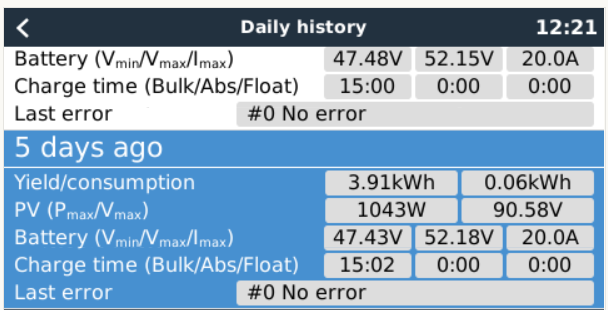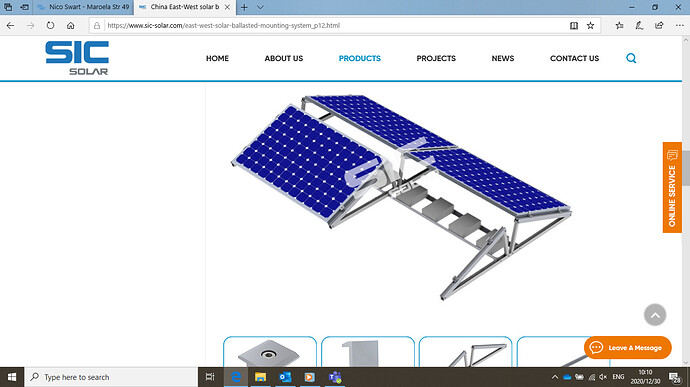I have something similar to this for 4 panels currently. So I’ll need to get 8 more.
The bonus is that you have 2x MPPT’s - 1 for E and 1 for W.
The 410W modules may be pushing the limits of the MPPT’s (2s 3p configuration) but they can be 30% oversized (tbc please). Your panels could be arranged with the 415W on one MPPT and the 410W on another. The panel shading will then also be managed a bit better. Add another string to the “afdak” in future.
@JacoDeJongh => QA Please 
Cheers
Mark
That correct.
I have read in your data sheet that the max amp charging amps is 50… so I guess below 50 is correct.
That on the other hand is not 100% true. Your inverter can only require a max of 62.5 amps at full load…
so even if you change the setting, it cant prevent that draw from the batteries, the only way to limit it in your setup is to limit the inveter power and force it to draw the rest from the grid in the event that the loads are higher than the setting.
Hi Mark, sorry, but I am not sure what you ask here…
QA = Quality Assuance check please 
As long as the max voltage rating is not exceeded, all should be fine. Each MPPT can give a max of 55.6volt x 35 A = 1946 Watts and his got 2460whp on the first MPPT and 2490whp on the second, - 20% expected losses = 1992wh per MPPT. So he is literally at his usable max…
Any reason you are not putting some panels on the “afdak”?
Also, I would split the MPPTs as one North and the other EAST/WEST panels. I’ve done that is it works very well. As long as a string’s panels all point the same direction then another string in parallel can point in another direction with very minimal loss.
I do guess those Canadian panels have max Volts of more than 50V each? Else you could have done 3s2p.
Just some clarity please as this worries me a little. I know that the max volts must never be exceeded. Watts and amps can go a little over the max which I was told was fine.
So in the case of the 1st MPPT, 3 strings in parallel consisting of two seried panels each (at 47.6 Voc) gives me only 95.2V),which is very far from 150V the MPPT is rated for.
The other MPPT with 415W panels gets me to 95.6V
So when you say I am at my max operating limits are you referring to the watts? Which I know I have exceeded but was told that this is not much of an issue. I know the MPPT is rated at max 2000W
What I am saying is, that you are fine as it is and that the Mppt can only deliver what can be expected from your panels.
EDIT: Victron MPPT are so great in maintaining the max rating on its output, that it doesn’t even matter if you connect double the amount af panels. It will be a total waste of money as you would receive no benifit at all by doing that, but it’s safe to do it. I have tested this for over 18 months.
Strings of 3s2p would have seen smoke escape from the MPPT’s yes. They are too close for comfort to the MPPT max at 47.6V and 47.8V for the 410 & 415 watt panels respectively.
No real reason I’m not using the afdak. All panels on my string now face the same direction, but in future I will consider another MPPT with a North facing string. The only reason I did not use it right from the onset is because there is 2 large trees that causes a lot of shade for a large part of the day.
Happiness!!! Thank you!
So if I want to protect my lead acids somewhat, I could lower the max power of the inverter to say 2000W, which would allow for a max amp draw of 41.6A from the batteries?
But then this also means that on good sunny days that the panels will be choked and not be able to supply full loads that is demanded? Is my reasoning correct?
I have to disagree with this. I install 410s 3s a lot with no problem at all. For you to exceed the voltage under load is virtually impossible. You would also need 0 degree c with pretty good sun to exceed the VOC, and in Pta that would never happen.
I agree with Jaco on this.
I have 425W panels that have Voc at 49V(STC) and 45Voc(NOCT) which is the mac Volts when the panels are not connected to anything (the breaker is open).
As soon as you connect it to your system (close the breaker) the load will pull this voltage down, so this is where the Vmp values come in which is lower (40.4V and 37.3V in my instance).
Now if you reach your max power(perfect sun angle mid day) while the temperatures are very low(<6 degrees) then it can go over those values.
Most panel manufacturers measure these as:
STC - Irradiance 1000 W/m2, cell temp @ 25°C
NOCT - Irradiace 800 W/m2, cell temp @ 20°C
So the chance you will see that this is not really possible in most places in SA. If you live near Sutherland, or near Lesoto where it can snow mid day you should be more pessimistic. But remember this is the temp of the cells. The panel gets heated as soon as some rays fall on it
As an example here is my max that my MPPTs had to handle. This was from the past winter where we had snow on the mountains.

This is from a normal summer day

And a few days back when it was cooler and partly overcast

Aaah had I but known this/you before I started out I would have done it differently then.
I remember reading what you said on another thread that the higher the volts is, the easier it is to convert it to what you want with less losses. So efficiency would be better then?
It was that cloud edge phenomenon that bothered me. Cool days as you said with plenty sun - winter conditions.
The danger lies in the VOC. With no load connected. Once the MPPT connects to the load, the volts drop to roughly 120 volts and lower, you would need some serious cloud edge effect to pick that up to 150. Please also keep in mind that the MPPT has a high voltage protection as well. It will stop working at voltages above 145 in an attempt to protect it self. @plonkster, can you explain this part please?
Oh there is not much to explain, but basically, if the input voltage is over 145V it stops working (ie it will not charge batteries). The assumption is that generally as the sun comes up the voltage rises from below, so when it exceeds 145V you still have a small window within which you can do something to prevent damage to the charger.
So between 145V and 150V, the charger does not blow up… but it also does not charge. What precisely happens at this point I am not certain, but if I recall, it actually clamps the voltage (ie it “shorts” the PV input) to hold the voltage below 150V and protect the charger. But I am not sure about this part.
I recall this type of panel mounting: Renusol CS60 - Ballasted Mounting System for Flat Roofs
Or as you mentioned lintols and other weights: Balast and other flat roof mounting system for solar panels
Just need to be sure I understand this. It will drop to 120V and lower, assuming that VOC was roughly/close to 150V in the case of an MPPT rated to 150V as max?
So again the 80% efficiency thing. In my case this would mean that if I had 96Voc to begin with, my workable volts would drop to about 77V
Then I assume that there is not much “room” for the MPPT to manoeuvre in tracking the max power point and working its magic? Would higher volts be more beneficial to the system’s overall efficiency?
The MPPT only start charging when the voltage from the panels are about 10V higher than what is in the batteries.
So if you battery is currently at 48V the MPPT will start charging when the panels reach 58V+. If you have 150V strings then you will reach that 58V easier/sooner. But in reality the panels love their Voc/Vmp values at reach it as soon as there is some light on them, so the impact is small, except if your string voltage is very close to that 58/60V are.
The big benefit come in the size and amount of cables you have to install. At 150V you can have 3 panels per string that does not raise your current (so smaller cables).
You already have your cables installed so again the impact currently is small.
But you can add more panels on the same strings without needing more cables or MPPTs if you go to 150V.
I must say that I am tempted to add 1 more panel to each of the 6 strings once funds allow.
This would give me 142Voc on each MPPT but I would have to get real creative with spacing them on my roof, as this would mean 6 additional panels. which will take up a huge amount of space. Maybe move them to the corrugated afdak.
But given my 2,4Kva inverter, would there really be any substantial benefit in doing so?
With good sun my panels pushes about 82V
